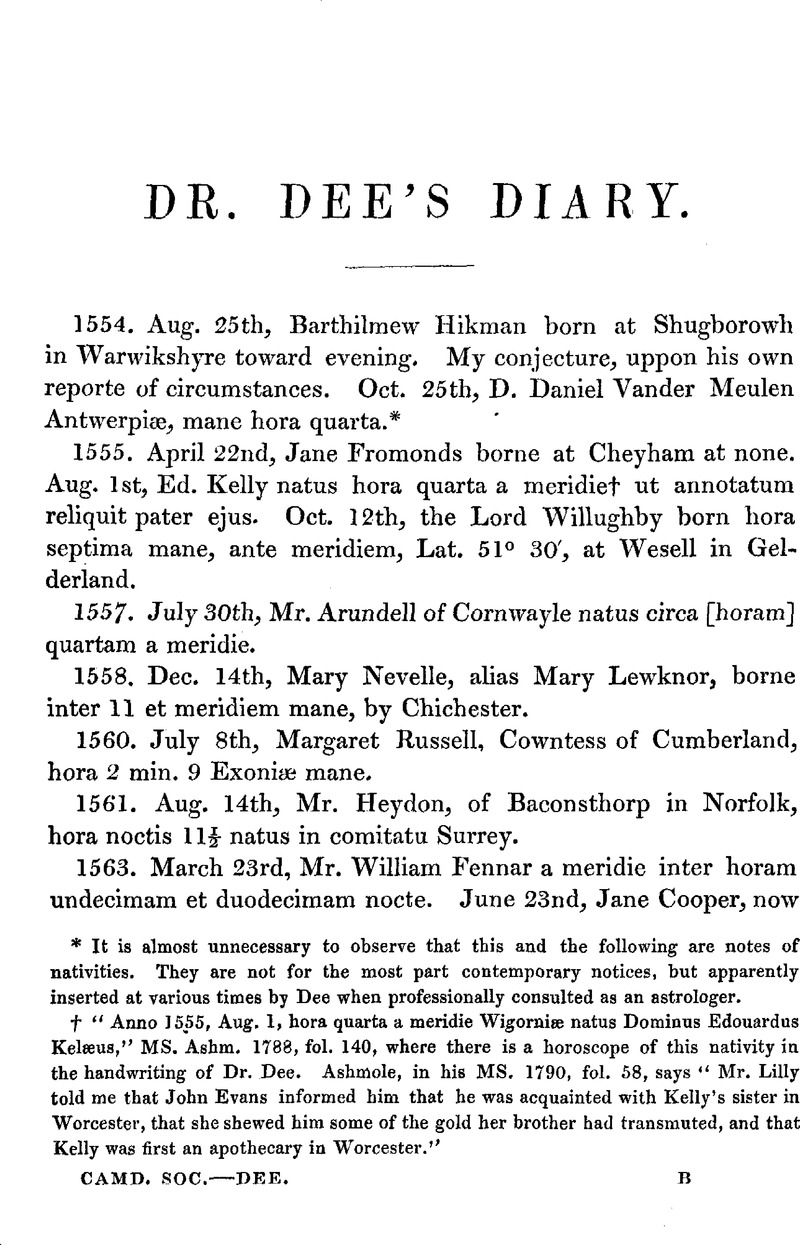No CrossRef data available.
Article contents
Dr. Dee's Diary
Published online by Cambridge University Press: 23 February 2010
Abstract

- Type
- Dr. Dee's Diary
- Information
- Camden Old Series , Volume 19: The Private Diary of Dr. John Dee, and the Catalogue of his Library of Manuscripts , June 1842 , pp. 1 - 64
- Copyright
- Copyright © Royal Historical Society 1842
References
page 1 note * It is almost unnecessary to observe that this and the following are notes of nativities. They are not for the most part contemporary notices, but apparently inserted at various times by Dee when professionally consulted as an astrologer.
page 1 note † “Anno 1555, Aug. 1, hora quarta a meridie Wigomise natus Dominus Edouardns Kelæus,” MS. Ashm. 1788, fol. 140, where there is a horoscope of this nativity in the handwriting of Dr. Dee. Ashmole, in his MS. 1790, fol. 58, says “Mr. Lilly told me that John Evans informed him that he was acquainted with Kelly's sister in Worcester, that she shewed him some of the gold her brother had transmuted, and that Kelly was first an apothecary in Worcester.”
page 2 note * The brother of the celebrated astrologer before mentioned.
page 2 note † “Dr. Dee dwelt in a house neere the water side, a little westward from the church [at Mortlake]. The buildings which Sir Fr. Crane erected for working of tapestry hangings, and are still (1673) employed to that use, were built upon the ground whereon Dr. Dee's laboratory and other roomes for that use stood. Upon the west is a square court, and the next is the house wherein Dr. Dee dwelt, now inhabited by one Mr. Selbury, and further west his garden.”—MS. Ashm. 1788, fol. 149. The same account says that “Dr. Dee was wel beloved and respected of all persons of quality thereabouts, who very often invited him to their houses or came to his.”
page 3 note * This of course is his celebrated Monas Hieroglyphica, frequently printed, and the nature of which I attempted to explain in a paper read before the Society of Antiquaries. Mr. Herbert, according to MS. Ashm. 1788, “dwelt then in Mortlack and was an intimate friend of Dr. Dee's.”
page 3 note † This was his work printed in 1577 under the title of General and Rare Memorials pertayning to the perfect Art of Navigation, in folio, now a book of the greatest rarity. The original manuscript of it is in MS. Ashm. 1789, and Dee's own copy of the published work with MS. notes and additions is preserved in the British Museum. In his Letter Apologetical, 4to. Lond. 1603, he cites this work under the title of The Brytish Monarchic, as having been written in the year 1576.
page 4 note * Ashmole informs us that Walsingham continued for a length of time one of Dr. Dee's best patrons.
page 4 note † Rogers was a member of the University of Oxford, and a large commonplace-book in his handwriting is in Archbishop Tenison's library in St. Martin's-in-the-Fields.
page 4 note ‡ That is, Galfridus Monumetensis de gestis regum Britannia. Hackluyt mentions this fact in his collection of voyages.
page 4 note § This is the book just mentioned under the title of General and Rare Memorials, fol. Lond. 1577.
page 6 note * His horoscope is in MS. Ashm. 1788. “Mr. Arthur Dee's birth was accompanied by the unhappy accident of the death of Mr. Fromonds, his mother's father, who died that morning.”—MS. Ashm. 1790, fol. 63.
page 6 note † This person is not noticed by the Oxford biographers.
page 7 note * Dee has occasionally made use of Greek letters for the preservation of his notes, still retaining the English language. The present passage may as well be given:—” This night my wife dreamed that one cam to her and touched her, saying, ‘Mistres Dee, you are conceived of child, whose name must be Zacharias ; be of good chere, he sal do well as this doth ! ‘“
page 7 note † In a more appropriate place I shall give from an Ashmolean manuscript a traditionary anecdote relating to this Roger Coke, or Cooke, and the great secret which Dee revealed to him.
page 9 note * His first wife died on the 16th of March 1575, when “the Queen's Majestie, with her most honourable Privy Council, and other her Lords and Nobility, came purposely to have visited my library: but finding that my wife was within four houres before buried out of the house, her Majestie refused to come in ; but willed to fetch my glass so famous, and to show unto her some of the properties of it, which I did ; her Majestie being taken down from her horse by the Earle of Leicester, Master of the Horse, at the church wall of Mortlake, did see some of the properties of that glass, to her Majestie's great contentment and delight.”—Compendious Memorial, p. 516. This glass is spoken of again.
page 10 note * Dee has made a rough sketch of the appearance of this comet, with its long tail, on the margin of the MS.
page 10 note † An original diary of the chemical experiments made by Dr. Dee in this year is preserved in the Bodleian Library.—MS. Rawl. Miscel. 241.
page 12 note * Dr. Dee, in the Rawlinson MS. just quoted, observes, in his notes on this month, “Mr. Harry Waters went away the 2nd day, malcontent. John Dee, Jesus bless me!”
page 13 note * This probably gave rise to the anecdote which is related in MS. Ashm. 1788, fol. 147, viz. that “he revealed to one Roger Cooke the great secret of the elixar, as he called it, of the salt of metalls, the projection whereof was one upon an hundred.”
page 15 note * Just above this relation some one has written, “you that rede this underwritten assure yourselfe that yt is a shamfull lye, for Talbot neither studied for any such thinge nor shewed himselfe dishonest in any thinge.” Dr. Dee has thus commented upon it:—” This is Mr. Talbot or that lerned man, his own writing in my boke, very unduely as he cam by it.” There are several other notices of Talbot erased, but whether by him or by the Doctor it is impossible to say, but most probably the former.
page 19 note * This work, although never entirely printed, created much sensation at the time, and was the cause of considerable controversy among the politicians as well as literati. The Memorial on this subject which Dee presented to the Privy Council has been printed by Hearne and others, but it is not generally known that the original manuscript of the actual treatise on the correction of the Calendar is still preserved in Ashmole's library, No. 1789, and is the very book which Dee alludes to above. It is inscribed “to the Right Honorable and my singular good Lorde, the Lorde Burghley, Lorde Threasorer of Englande,” with the following verses :—
“
I shew the thing and reason why;
At large, in breif, in middle wise,
I humbly give a playne advise;
For want of tyme, the tyme untrew
Yf I have myst, commaund anew
Your honor may. So shall you see
That love of truth doth govern me.”
The work itself is entitled, “A playne Discourse and humble Advise for our Gratious Gueene Elizabeth, her most Excellent Majestie to peruse and consider, as concerning the needful Reformation of the Vulgar Kalender for the civile yercs and daies accompting, or verifyeng, according to the tyme truely spent.”
page 20 note * “The year of our Lorde God 1583, the laste daye of Aprill, the Duke or Prince of Vascos in Polonia, oame to London and was lodged at Winchester Howse.”—MS. Douce, 303, fol. 125. This account differs from Dee's by a single day.
page 21 note * “Her Majestie being informed by the Right Honourable Earle of Leicester, that whereas the same day in the morning he had told me that his Honour and Lord Laskey would dine with me within two dayes after, T confessed sincerely unto him that I was not able to prepare them a convenient dinner, unless I should presently sell some of my plate or some of my pewter for it. Whereupon her Majestie sent unto me very royally within one hour after forty angels of gold from Sion, whether her Majestie was now come by water from Greenwich.”—Dr. Dee's Compendious Memoriall, p. 511.
page 22 note * He frequently speaks of Prince Albert Leski under the title of Illustrissimus.
page 22 note † It is almost unnecessary to observe that these initials refer to Edward Kelly.
page 24 note * That is, Thomas Kelley and John Carp.
page 29 note * This refers to the earliest English translation of Euclid by Billingsley, which was published in 1570, with a long preface by Dr. Dee. Professor De Morgan is of opinion that the translation also was by Dee, or that Billingsley may have been only a pupil who worked immediately under his directions. The passage to which Dee alludes is as follows:—“a man to be curstly affrayed of his owne shadow; yea, so much to feare, that if you, being alone nere a certaine glasse, and proffer, with dagger or sword, to foyne at the glasse, you shall suddenly be moved to give backe (in maner) by reason of an image appearing in the ayre betwene you and the glasse with like hand, sword, or dagger, and with like quicknes, foyning at your very eye, likewise as you do at the glasse. Straunge this is to heare of, but more mervailous to behold then these my wordes cam signifie ; and neverthelesse by demonstration opticall the order and cause therof is certified ; even so, as the effect is consequent.” I refer the reader also to Mr. Barlow's History of Optics in the Encyclopedia Metropolitana.
page 32 note * Where, according to Aubrey, who received his information from Lilly, he was very favourably received by her Majesty.
page 33 note * There are a great many brief notices in this diary relatiye to Jane Dee, most of which are expressed in astrological symbols ; and as they are exceedingly difficult to decipher satisfactorily, and are certainly of very little, if any importance, I have thought it expedient to omit them. The entry of “ ”is also of frequent occurrence, though what “θεμ “can refer to I have not been able to discover.
”is also of frequent occurrence, though what “θεμ “can refer to I have not been able to discover.
page 34 note * Dee has preserved several interesting notices of his intimacies with the principal navigators of his time. A general reference to Hackluyt will be sufficient.
page 37 note * See the “Compendious Rehearsall,” published by Hearne from a Manuscript in the Cottonian collection, now partially destroyed by fire, for a more extended account of this.
page 38 note * Now in the Cottonian collection. Ashmole has preserved a copy of it in MS. Ashm. 1790.
page 41 note * This entry is not very clear. It either refers perhaps to Harriot, the celebrated mathematician, or to the London goldsmith whom the Abbotsford novelist has immortalized.
page 43 note * This notice is particularly interesting, showing the intimate connexion which existed between the first English mathematician of the day and the philosopher of Mortlake.
page 63 note * In a note by Dee in MS. Ashm. 488, he says, “All Barthilmew's reports of sight and hering spirituall wer burnt; a copy of the first part, which was afterward fownd, was burnt before me and my wife.”




